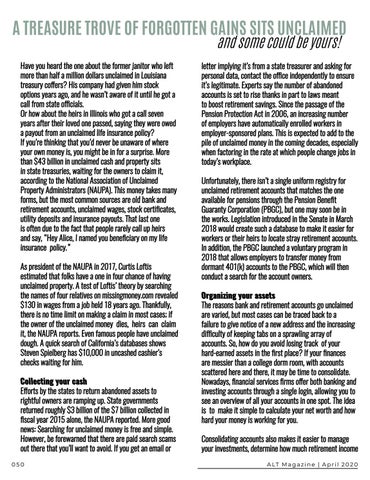A TREASURE TROVE OF FORGOTTEN GAINS SITS UNCLAIMED and some could be yours!
Have you heard the one about the former janitor who left more than half a million dollars unclaimed in Louisiana treasury coffers? His company had given him stock options years ago, and he wasn’t aware of it until he got a call from state officials. Or how about the heirs in Illinois who got a call seven years after their loved one passed, saying they were owed a payout from an unclaimed life insurance policy? If you’re thinking that you’d never be unaware of where your own money is, you might be in for a surprise. More than $43 billion in unclaimed cash and property sits in state treasuries, waiting for the owners to claim it, according to the National Association of Unclaimed Property Administrators (NAUPA). This money takes many forms, but the most common sources are old bank and retirement accounts, unclaimed wages, stock certificates, utility deposits and insurance payouts. That last one is often due to the fact that people rarely call up heirs and say, “Hey Alice, I named you beneficiary on my life insurance policy.” As president of the NAUPA in 2017, Curtis Loftis estimated that folks have a one in four chance of having unclaimed property. A test of Loftis’ theory by searching the names of four relatives on missingmoney.com revealed $130 in wages from a job held 18 years ago. Thankfully, there is no time limit on making a claim in most cases; if the owner of the unclaimed money dies, heirs can claim it, the NAUPA reports. Even famous people have unclaimed dough. A quick search of California’s databases shows Steven Spielberg has $10,000 in uncashed cashier’s checks waiting for him. Collecting your cash Efforts by the states to return abandoned assets to rightful owners are ramping up. State governments returned roughly $3 billion of the $7 billion collected in fiscal year 2015 alone, the NAUPA reported. More good news: Searching for unclaimed money is free and simple. However, be forewarned that there are paid search scams out there that you’ll want to avoid. If you get an email or 050
letter implying it’s from a state treasurer and asking for personal data, contact the office independently to ensure it’s legitimate. Experts say the number of abandoned accounts is set to rise thanks in part to laws meant to boost retirement savings. Since the passage of the Pension Protection Act in 2006, an increasing number of employers have automatically enrolled workers in employer-sponsored plans. This is expected to add to the pile of unclaimed money in the coming decades, especially when factoring in the rate at which people change jobs in today’s workplace. Unfortunately, there isn’t a single uniform registry for unclaimed retirement accounts that matches the one available for pensions through the Pension Benefit Guaranty Corporation (PBGC), but one may soon be in the works. Legislation introduced in the Senate in March 2018 would create such a database to make it easier for workers or their heirs to locate stray retirement accounts. In addition, the PBGC launched a voluntary program in 2018 that allows employers to transfer money from dormant 401(k) accounts to the PBGC, which will then conduct a search for the account owners. Organizing your assets The reasons bank and retirement accounts go unclaimed are varied, but most cases can be traced back to a failure to give notice of a new address and the increasing difficulty of keeping tabs on a sprawling array of accounts. So, how do you avoid losing track of your hard-earned assets in the first place? If your finances are messier than a college dorm room, with accounts scattered here and there, it may be time to consolidate. Nowadays, financial services firms offer both banking and investing accounts through a single login, allowing you to see an overview of all your accounts in one spot. The idea is to make it simple to calculate your net worth and how hard your money is working for you. Consolidating accounts also makes it easier to manage your investments, determine how much retirement income A LT M a g a z i n e | A p r i l 2 0 2 0



